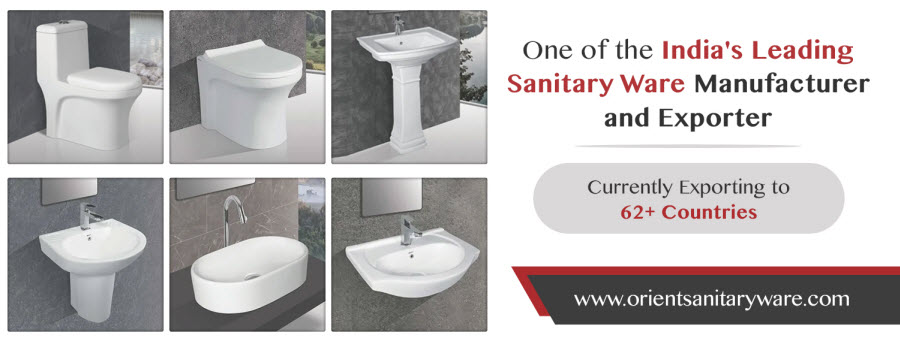
Introduction
The ceramic sanitaryware industry in India has seen remarkable growth in recent years, driven by a combination of factors such as government initiatives, increasing disposable income, and changing consumer preferences. According to industry estimates, the Indian ceramic sanitaryware market is expected to grow at a CAGR of around 12% during the period of 2021-2026. This article provides an overview of the growth of the ceramic sanitaryware industry in India, including its history, current state, and future prospects.
History of the Ceramic Sanitaryware Industry in India
The ceramic sanitaryware industry in India has a long and rich history, dating back to the 1960s. The industry initially started with a few players, who manufactured basic sanitaryware products such as washbasins, pedestals, and water closets. However, over time, the industry has evolved and grown significantly, with several players now manufacturing a wide range of premium sanitaryware products, including designer washbasins, shower panels, and bathtubs.
One of the major milestones in the industry's history was the establishment of the Morbi cluster in Gujarat in the 1990s. The Morbi cluster is one of the largest ceramic clusters in the world and is home to several ceramic sanitaryware manufacturers. The cluster has played a pivotal role in the growth of the ceramic sanitaryware industry in India, contributing significantly to the industry's exports.
Current State of the Ceramic Sanitaryware Industry in India
The current state of the ceramic sanitaryware industry in India is characterized by a rapidly growing market, driven by increasing demand for premium and designer products. The market size for ceramic sanitaryware in India was estimated to be around INR 2,800 crore in 2020, with a projected CAGR of 12% during 2021-2026.
The market is segmented into various categories such as washbasins, water closets, pedestals, urinals, and cisterns, among others. The washbasin segment dominates the market, accounting for more than 40% of the market share. The water closets segment is the second largest, followed by pedestals and urinals.
The ceramic sanitaryware industry in India is highly competitive, with several players operating in the market. The industry faces several challenges and opportunities. One of the major challenges is the intense competition in the market, with players vying for market share through aggressive pricing and marketing strategies. Additionally, the industry is heavily dependent on imports for raw materials such as clay and feldspar, leading to price volatility and supply chain disruptions.
On the other hand, the industry presents several opportunities, driven by increasing demand for premium and designer sanitaryware products. Furthermore, the Indian government's focus on promoting sanitation and hygiene, through initiatives such as Swachh Bharat Abhiyan and Atmanirbhar Bharat, is expected to provide a significant boost to the industry.
Technology and innovation have also had a significant impact on the ceramic sanitaryware industry in India. Industry players are investing heavily in research and development to create new and innovative products, such as self-cleaning toilets and touchless faucets, that offer enhanced user experience and convenience. Additionally, the adoption of digital technologies such as e-commerce and digital marketing has enabled players to reach a wider audience and expand their market share.
Overall, the ceramic sanitaryware industry in India is expected to witness robust growth in the coming years, driven by increasing demand for premium and designer products, government initiatives, and technological advancements. However, the industry players must navigate challenges such as intense competition and raw material sourcing issues to capitalize on these opportunities and drive sustained growth.

Growth Drivers for the Ceramic Sanitaryware Industry in India
The ceramic sanitaryware industry in India is poised for significant growth in the coming years, driven by several key factors. Some of the major growth drivers for the industry include:
1. Government initiatives to promote sanitation and hygiene: The Indian government has launched several initiatives, such as Swachh Bharat Abhiyan, to promote sanitation and hygiene in the country. This has led to increased demand for sanitaryware products, including toilets and washbasins, creating significant growth opportunities for the industry.
2. Growing demand for premium sanitaryware products: With rising disposable incomes and changing consumer preferences, there has been a growing demand for premium and designer sanitaryware products in India. Players in the industry are catering to this demand by offering a wide range of premium products, including luxury toilets, designer washbasins, and high-end faucets.
3. Increasing disposable income and changing consumer preferences: The increasing disposable income of the middle-class population in India has led to a shift in consumer preferences towards more sophisticated and premium products. Consumers are now willing to pay a premium for high-quality, designer sanitaryware products that offer enhanced aesthetics and functionality.
4. Growing demand for green and sustainable products: There has been a growing awareness among consumers regarding the environmental impact of their choices. As a result, there is a growing demand for green and sustainable sanitaryware products that are made from eco-friendly materials and have low water consumption. This has led to the development of innovative and sustainable products in the industry, such as waterless urinals and low-flow toilets.
Overall, these growth drivers are expected to fuel the growth of the ceramic sanitaryware industry in India in the coming years, creating significant opportunities for players in the industry. However, industry players must also address the challenges such as intense competition, supply chain disruptions, and raw material sourcing issues to capitalize on these growth opportunities and drive sustained growth.

Challenges for the Ceramic Sanitaryware Industry in India
The ceramic sanitaryware industry in India faces several challenges that can hinder its growth and profitability. Some of the major challenges faced by the industry include:
1. Intense competition in the market: The ceramic sanitaryware industry in India is highly competitive, with many established players and new entrants vying for a share of the market. This has led to intense price competition, with players offering discounts and promotions to attract customers.
2. Dependence on imports for raw materials: India relies heavily on imports for the raw materials required for manufacturing ceramic sanitaryware products, such as feldspar, clay, and kaolin. This dependence on imports can lead to supply chain disruptions and price volatility, affecting the profitability of players in the industry.
3. Price volatility of raw materials: The prices of raw materials required for manufacturing ceramic sanitaryware products are subject to frequent fluctuations. This can lead to unpredictable production costs and affect the profitability of players in the industry.
4. Lack of skilled labor and trained professionals: The ceramic sanitaryware industry requires skilled labor and trained professionals to manufacture high-quality products efficiently. However, there is a shortage of skilled labor and trained professionals in the industry, leading to delays in production and lower productivity.
To overcome these challenges, industry players must adopt innovative strategies such as investing in research and development, building a resilient supply chain, and training and upskilling their workforce. Additionally, government support in the form of subsidies and incentives can also help address some of these challenges and promote the growth of the ceramic sanitaryware industry in India.
Future Prospects for the Ceramic Sanitaryware Industry in India
The future prospects for the ceramic sanitaryware industry in India look promising, with several growth drivers and emerging opportunities in the market. Some of the key factors that are expected to shape the future of the industry include:
1. Expected growth trends for the industry: The ceramic sanitaryware industry in India is expected to grow at a healthy rate in the coming years, driven by rising demand for premium products, increasing urbanization, and government initiatives to promote sanitation and hygiene.
2. Emerging opportunities and trends: The industry is witnessing a shift towards eco-friendly and sustainable products, with growing demand for water-efficient and energy-efficient sanitaryware products. Additionally, there is a rising trend towards customization, with consumers looking for unique and personalized designs.
3. Future challenges and risks: Despite the growth prospects, the industry faces several challenges and risks, including intense competition, price volatility of raw materials, and regulatory changes. Additionally, the emergence of new materials and technologies could disrupt the traditional market for ceramic sanitaryware products.
4. Strategic recommendations for industry players: To capitalize on the emerging opportunities and overcome the challenges, industry players must focus on innovation, building a strong brand, and investing in research and development. Additionally, they must build a resilient supply chain, adopt sustainable manufacturing practices, and invest in the training and development of their workforce.
Overall, the future of the ceramic sanitaryware industry in India looks promising, and players who are able to navigate the challenges and capitalize on the emerging opportunities are likely to succeed in the market.

Conclusion
In conclusion, the ceramic sanitaryware industry in India has witnessed significant growth in recent years, driven by several factors such as government initiatives, changing consumer preferences, and rising disposable incomes. The market has also been impacted by technology and innovation, leading to the development of more eco-friendly and sustainable products.
However, the industry also faces several challenges, including intense competition, dependence on imports for raw materials, price volatility of raw materials, and a shortage of skilled labor and trained professionals. These challenges need to be addressed by industry players to sustain the growth and profitability of the industry.
Looking towards the future, the ceramic sanitaryware industry in India is expected to continue its growth trajectory, with emerging opportunities such as customized and sustainable products. However, industry players must also be prepared to face potential risks and challenges such as regulatory changes and disruption from new technologies and materials.
In order to succeed in the industry, it is important for companies to focus on innovation, building a strong brand, investing in research and development, building resilient supply chains, adopting sustainable manufacturing practices, and investing in the training and development of their workforce.
Overall, the ceramic sanitaryware industry in India holds great potential for growth and innovation, and companies that are able to navigate the challenges and capitalize on the opportunities are likely to thrive in the market.
FAQs
Q-How is the Indian government promoting sanitation and hygiene?
The Indian government is promoting sanitation and hygiene through initiatives such as Swachh Bharat Abhiyan, which aims to achieve a clean India by 2022. The government is also promoting the use of toilets and improving access to clean water and sanitation facilities in rural areas.
Q-What are the key growth drivers for the ceramic sanitaryware industry in India?
The key growth drivers for the ceramic sanitaryware industry in India include government initiatives to promote sanitation and hygiene, growing demand for premium sanitaryware products, increasing disposable income and changing consumer preferences, and growing demand for green and sustainable products.
Q-What are the challenges facing the ceramic industry in India?
The industry in India faces several challenges, including intense competition, dependence on imports for raw materials, price volatility of raw materials, and a shortage of skilled labor and trained professionals.
Q-What is the future outlook for the industry in India?
The future outlook for the ceramic sanitaryware industry in India is positive, with expected growth trends driven by emerging opportunities such as customized and sustainable products. However, industry players must also be prepared to face potential risks and challenges such as regulatory changes and disruption from new technologies and materials. To succeed in the industry, companies should focus on innovation, building a strong brand, investing in research and development, building resilient supply chains, adopting sustainable manufacturing practices, and investing in the training and development of their workforce.
Make an Appoinment
Send us Message
Visit us at Address
Vagadiya Road, Thangadh - 363530,
Gujarat, India.
Gujarat, India.
© Copyright 2024, Orient Ceramics, All Rights Reserved.
Web Design & Development by Opal Infotech